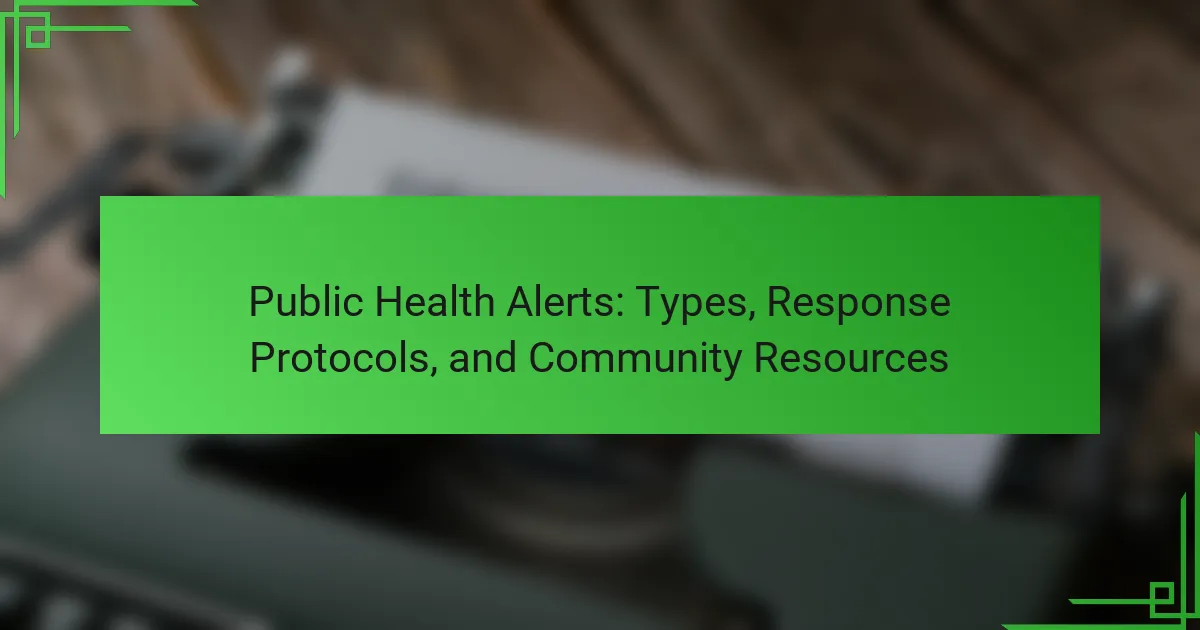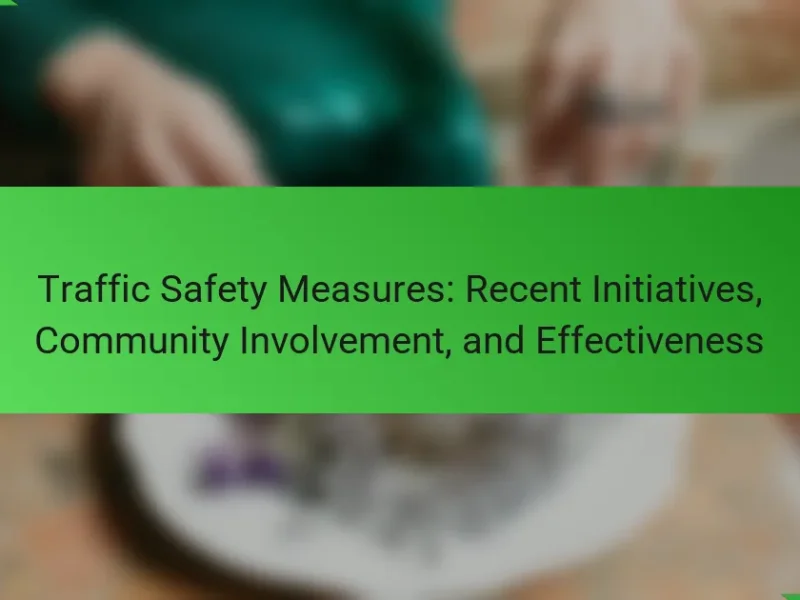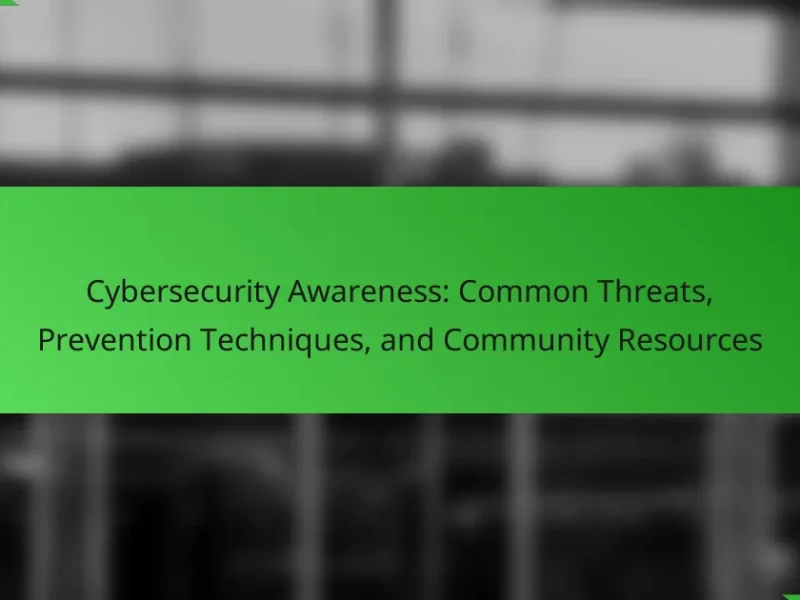Public health alerts are official notifications from health authorities that inform the public about health risks, including outbreaks and disease prevention. These alerts provide essential information on symptoms, transmission, and preventive measures, and are disseminated through various channels such as social media, press releases, and community outreach. The article outlines the types of public health alerts, response protocols, and the resources available to communities for effective communication during health crises. It emphasizes the importance of timely dissemination of information and the role of local health departments, the CDC, and community organizations in ensuring public safety.
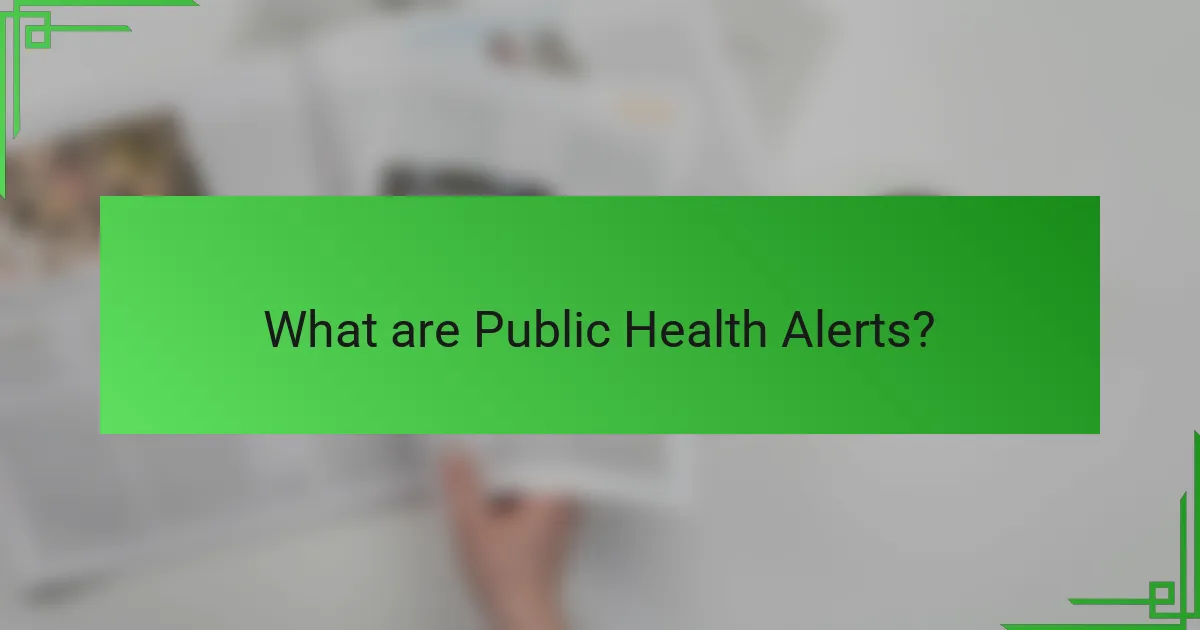
What are Public Health Alerts?
Public health alerts are official notifications issued by health authorities to inform the public about health risks. These alerts aim to raise awareness regarding outbreaks, disease prevention, or safety concerns. They provide crucial information on symptoms, transmission, and preventive measures. Public health alerts are often disseminated through various channels, including social media, press releases, and community outreach. For example, during the COVID-19 pandemic, public health alerts were issued to inform citizens about safety protocols and vaccination availability. These alerts help guide community responses and promote public safety.
Why are Public Health Alerts important for communities?
Public health alerts are crucial for communities as they provide timely information about health threats. These alerts help to inform residents about outbreaks, environmental hazards, or health advisories. By disseminating this information, communities can take necessary precautions to protect themselves. Alerts often include guidance on preventive measures and resources for assistance. For instance, during an outbreak, alerts may instruct individuals on vaccination locations or hygiene practices. Effective communication through alerts can reduce the spread of diseases and promote public safety. Research indicates that communities receiving timely health alerts experience lower infection rates during outbreaks.
What types of health risks do Public Health Alerts address?
Public Health Alerts address various health risks including infectious diseases, environmental hazards, and foodborne illnesses. Infectious diseases such as influenza, COVID-19, and tuberculosis are commonly reported. Environmental hazards include air and water quality issues, like lead contamination. Foodborne illnesses often involve outbreaks linked to specific products or restaurants. These alerts are crucial for timely public awareness and response to mitigate health risks. They rely on data from health departments and organizations to identify and communicate these threats effectively.
How do Public Health Alerts impact public awareness and safety?
Public Health Alerts significantly enhance public awareness and safety. They provide timely information about health risks, enabling individuals to take preventive measures. Alerts can inform the public about disease outbreaks, environmental hazards, and emergency health situations. For example, during the COVID-19 pandemic, alerts about symptoms and safety protocols were crucial in reducing transmission rates. Studies show that communities receiving timely alerts have better health outcomes. Increased awareness leads to higher compliance with health advisories, such as vaccinations and hygiene practices. Overall, Public Health Alerts are vital tools for protecting community health and safety.
What are the different types of Public Health Alerts?
Public health alerts primarily fall into three types: health advisories, health warnings, and health alerts. Health advisories provide information about potential health risks and recommended precautions. Health warnings indicate immediate threats to public health requiring urgent action. Health alerts inform the public about ongoing health situations, such as disease outbreaks. Each type serves a distinct purpose in communicating health-related information effectively.
How do emergency alerts differ from routine health advisories?
Emergency alerts provide immediate information about urgent threats, while routine health advisories offer general health guidance. Emergency alerts are issued during crises, such as natural disasters or disease outbreaks. They require prompt action to protect public safety. Routine health advisories, in contrast, address ongoing health issues or preventive measures. They do not usually necessitate immediate responses. Emergency alerts often convey critical details like evacuation routes or safety instructions. Routine health advisories typically include information on vaccination schedules or healthy lifestyle tips. The urgency and nature of the information differentiate these two types of alerts.
What role do travel advisories play in Public Health Alerts?
Travel advisories serve as critical tools in Public Health Alerts. They inform travelers about health risks associated with specific destinations. These advisories provide updated information on outbreaks, diseases, and safety measures. They guide individuals in making informed decisions about travel plans. For example, during disease outbreaks, advisories may recommend vaccinations or preventive measures. The Centers for Disease Control and Prevention (CDC) regularly issues travel health notices to communicate risks. This proactive communication helps minimize the spread of diseases across borders. Ultimately, travel advisories enhance public health safety by promoting awareness and precautionary actions.
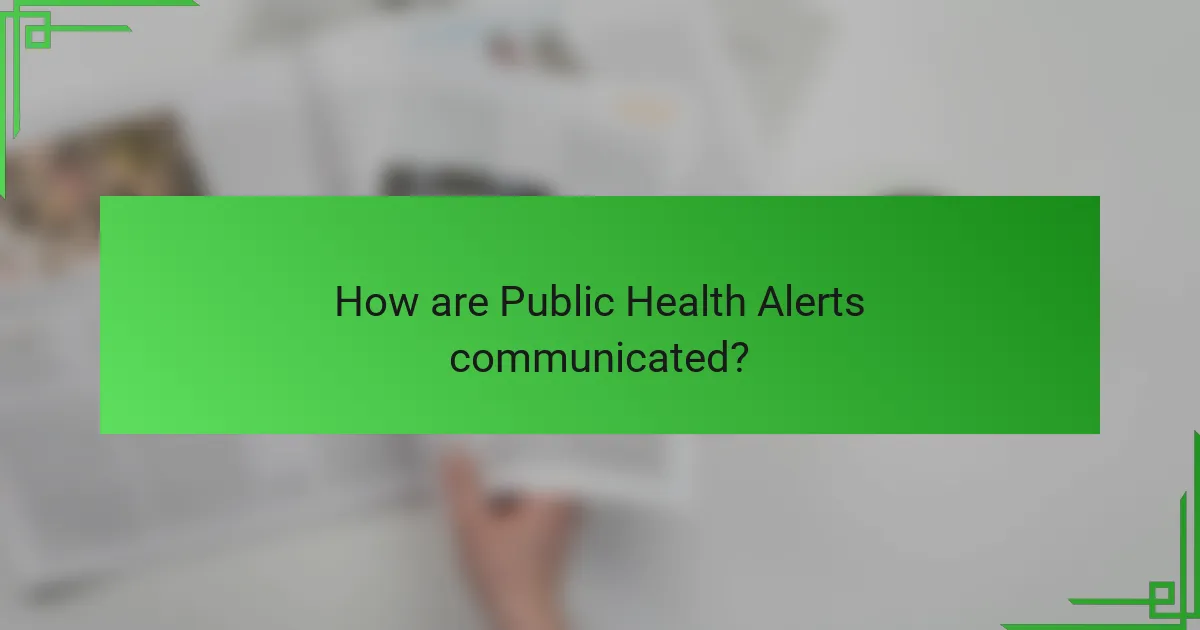
How are Public Health Alerts communicated?
Public Health Alerts are communicated through various channels. These include social media, public announcements, and official government websites. Health departments often use press releases to disseminate information quickly. Additionally, local news outlets play a crucial role in spreading alerts. Community organizations may also share alerts with their networks. Mobile notification systems can send alerts directly to residents’ phones. This multi-channel approach ensures broad reach and timely dissemination of information. Studies show that timely communication can significantly impact public response during health crises.
What channels are used to disseminate Public Health Alerts?
Public Health Alerts are disseminated through various channels. These include social media platforms, official government websites, and email notifications. Local news outlets also play a significant role in broadcasting alerts. Community organizations often share information through newsletters and community meetings. Mobile alert systems, such as text messages, are commonly used for urgent notifications. Additionally, public health departments utilize radio and television broadcasts for wider reach. Each channel serves to inform the public quickly and effectively about health risks and safety measures.
How effective are social media platforms in spreading Public Health Alerts?
Social media platforms are highly effective in spreading Public Health Alerts. They facilitate rapid dissemination of information to large audiences. Research indicates that messages on platforms like Twitter can reach millions within minutes. A study by the American Journal of Public Health found that social media significantly improved public awareness during health crises. Additionally, 70% of users reported that they trust health information shared on these platforms. This trust enhances the likelihood of message sharing and compliance. Social media also allows for real-time updates, which is crucial during evolving health situations. Overall, their extensive reach and immediacy make social media a vital tool for public health communication.
What traditional media methods are still relevant for Public Health Alerts?
Traditional media methods still relevant for Public Health Alerts include television, radio, and print media. Television broadcasts reach a wide audience quickly through news channels and emergency broadcasts. Radio remains effective for real-time updates, especially in areas with limited internet access. Print media, such as newspapers and flyers, provides tangible information that can be distributed in communities. These methods have been used historically to disseminate urgent health information, proving their reliability in crisis communication. For instance, during the COVID-19 pandemic, many health departments utilized radio and TV to share critical updates.
How can communities respond to Public Health Alerts?
Communities can respond to public health alerts by following established protocols. They should disseminate information quickly through local media and social platforms. Engaging with public health officials is crucial for accurate guidance. Communities must assess the situation and identify at-risk populations. Providing resources, such as vaccination clinics or testing sites, is essential. Organizing volunteer efforts can help distribute supplies and information. Regular updates should be communicated to keep the community informed. Collaboration with local organizations enhances the response effort.
What steps should individuals take when a Public Health Alert is issued?
When a Public Health Alert is issued, individuals should first stay informed through reliable sources. They should check local health department websites and official social media channels for updates. Next, individuals should follow any specific guidance provided in the alert. This may include recommendations for vaccination, avoiding certain areas, or practicing enhanced hygiene measures. Additionally, individuals should prepare for potential disruptions by stocking essential supplies. They should also communicate with family and friends to ensure everyone is aware of the situation. Monitoring symptoms and seeking medical advice if needed is crucial. Following these steps helps individuals stay safe and informed during health emergencies.
How can local organizations assist in responding to Public Health Alerts?
Local organizations can assist in responding to Public Health Alerts by providing timely information and resources. They can disseminate alerts through community networks, ensuring that residents receive crucial updates. Organizations can also facilitate access to healthcare services, such as vaccinations or screenings, during public health emergencies. Collaboration with local health departments enhances the effectiveness of response efforts. They can organize community meetings to educate the public about health risks and preventive measures. Additionally, local organizations can mobilize volunteers to support response initiatives. Evidence shows that community engagement improves public compliance with health directives. This collaborative approach strengthens overall community resilience during health crises.
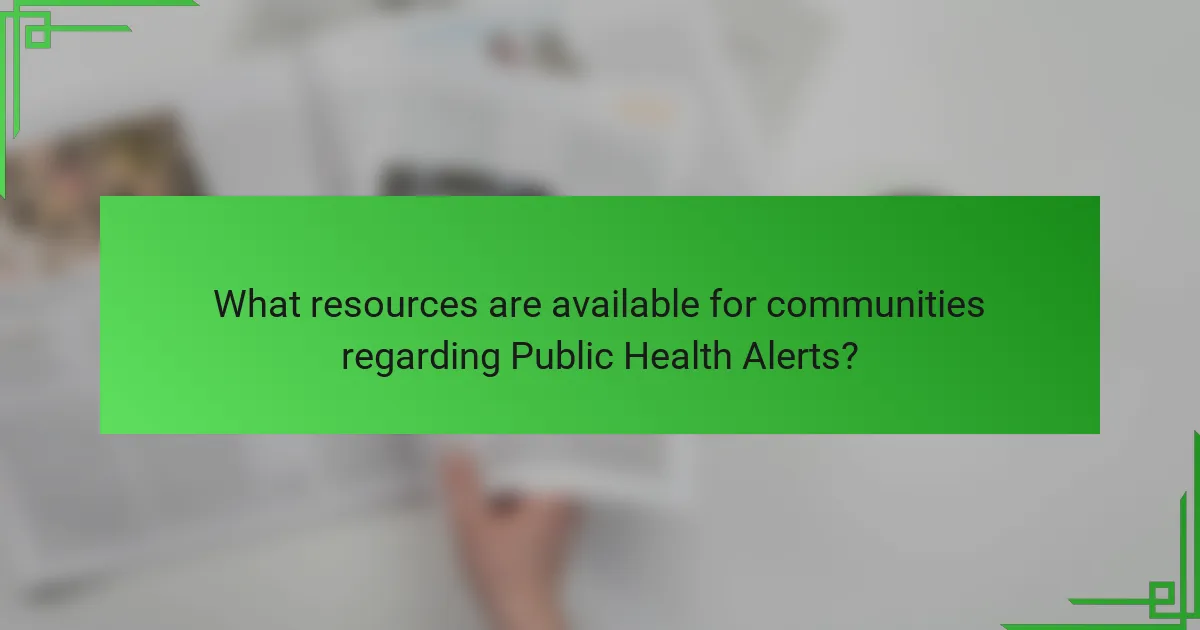
What resources are available for communities regarding Public Health Alerts?
Communities have access to various resources for Public Health Alerts. Local health departments provide timely information on health threats. The Centers for Disease Control and Prevention (CDC) offers guidelines and alerts on public health issues. State health agencies also disseminate alerts through official websites and social media. Community organizations often share information via newsletters and community meetings. Emergency management agencies coordinate public health responses and alerts. Online platforms and mobile apps can deliver real-time notifications to residents. Educational materials are available to help communities understand health risks. These resources ensure that communities stay informed and can respond effectively to public health alerts.
What types of community resources support Public Health Alerts?
Community resources that support Public Health Alerts include local health departments, community organizations, and emergency response teams. Local health departments provide essential information and guidance during public health emergencies. They disseminate alerts and coordinate response efforts with other agencies. Community organizations often assist in outreach and education efforts. They help share information with vulnerable populations. Emergency response teams are trained to act quickly during health crises. They facilitate communication and resource distribution. Collaboration among these resources enhances public awareness and response effectiveness.
How do local health departments contribute to Public Health Alert resources?
Local health departments contribute to Public Health Alert resources by monitoring health threats and disseminating information. They collect data on disease outbreaks and environmental hazards. This information is crucial for timely alerts to the community. Local health departments also coordinate with state and federal agencies. They ensure that public health messages are consistent and accurate. Additionally, they provide educational resources to the public. These resources help individuals understand health risks and preventive measures. Their involvement enhances community preparedness and response to public health emergencies.
What educational materials are available to help communities understand Public Health Alerts?
Educational materials available to help communities understand Public Health Alerts include brochures, websites, and workshops. Brochures provide concise information about specific health alerts. Websites offer up-to-date resources and guidelines from health authorities. Workshops facilitate interactive learning experiences for community members. Additionally, social media platforms disseminate real-time alerts and educational content. These materials enhance community awareness and preparedness regarding public health issues. Access to these resources is often provided by local health departments and organizations.
What best practices should communities follow in relation to Public Health Alerts?
Communities should establish clear communication channels for public health alerts. This includes utilizing local media, social media, and community websites. Timely dissemination of information is crucial. Alerts should be issued as soon as possible to ensure public awareness. Communities must ensure that information is accessible to all demographics. This involves translating alerts into multiple languages if necessary. Regular training for community leaders on alert protocols is essential. Engaging with local health departments can enhance response strategies. Feedback mechanisms should be established to assess the effectiveness of alerts. These practices improve community readiness and response to health threats.
How can community members stay informed about ongoing Public Health Alerts?
Community members can stay informed about ongoing Public Health Alerts through various reliable channels. These include official health department websites, local news outlets, and social media platforms. Health departments often post updates and alerts in real-time on their websites. Local news organizations provide coverage and updates on public health issues affecting the community. Social media accounts of health departments allow for immediate dissemination of information. Additionally, community health centers may distribute alerts directly to residents. Subscribing to email newsletters from health agencies can also provide timely information. These methods ensure that community members receive accurate and up-to-date public health information.
What role does preparedness play in effective response to Public Health Alerts?
Preparedness is crucial for an effective response to Public Health Alerts. It enables timely action and resource allocation during health emergencies. Preparedness involves planning, training, and coordination among public health agencies. For instance, the Centers for Disease Control and Prevention (CDC) emphasizes that communities with established emergency plans respond more effectively. Research shows that well-prepared regions mitigate the impact of health threats significantly. Preparedness reduces confusion and enhances communication during a public health crisis. Overall, it is a foundational element that supports swift and organized responses to protect public health.
Public health alerts are official notifications from health authorities designed to inform the public about health risks, outbreaks, and safety concerns. This article outlines the importance of these alerts for community awareness and safety, detailing the types of health risks they address, including infectious diseases and environmental hazards. It also explores the various channels used for communication, such as social media and traditional media, and emphasizes the role of local organizations and health departments in disseminating information and resources. Additionally, the article highlights best practices for community response and the significance of preparedness in effectively managing public health alerts.
